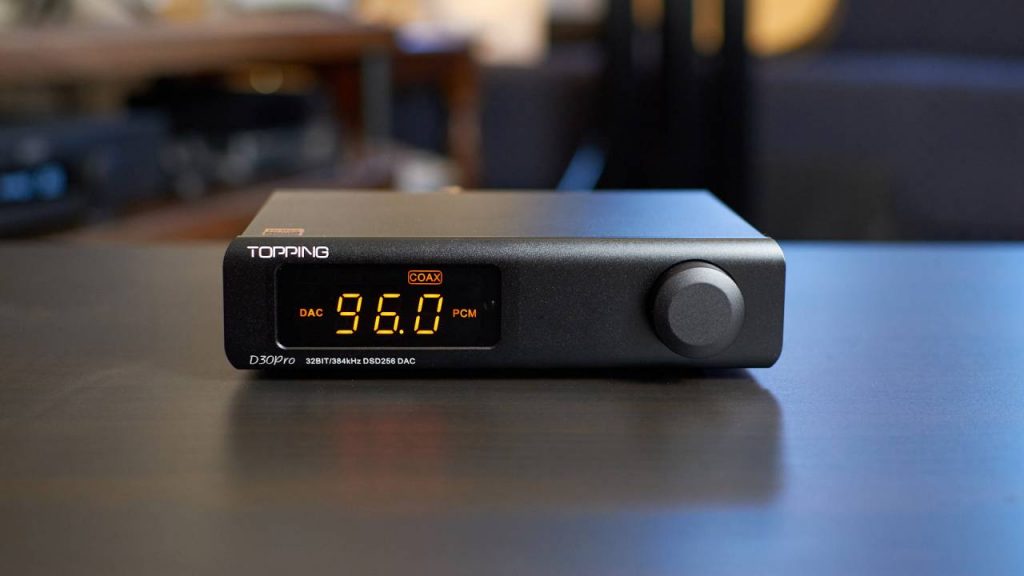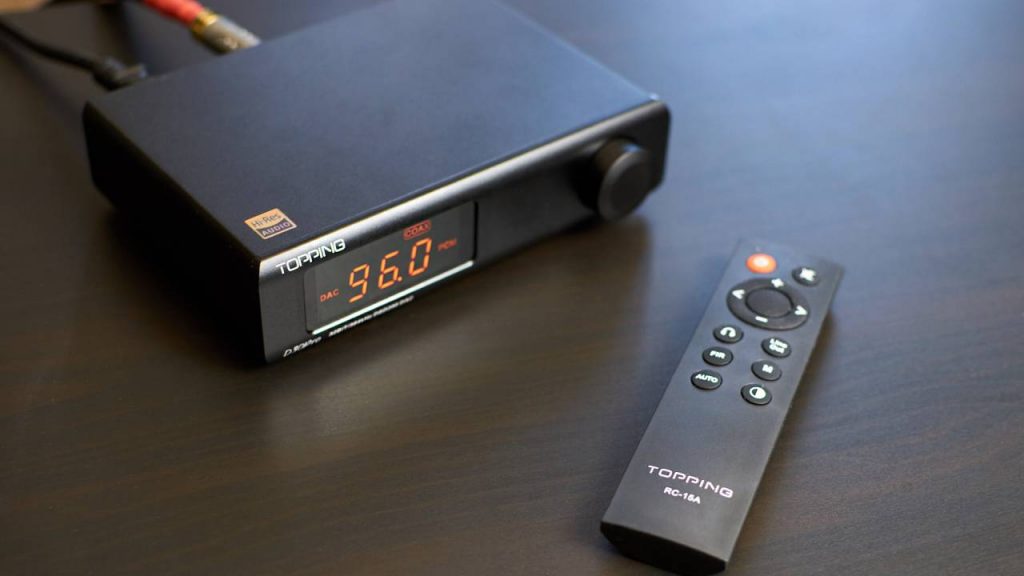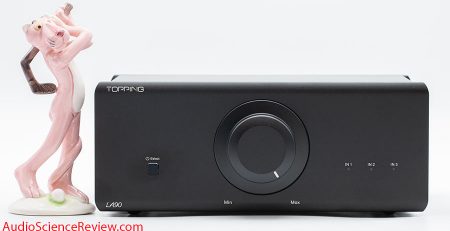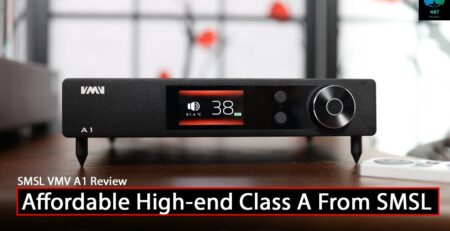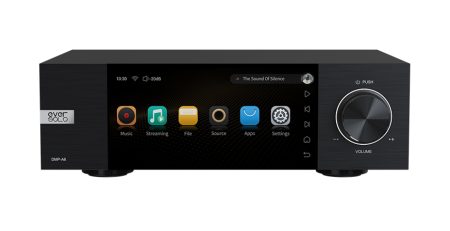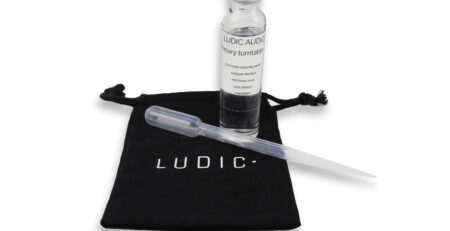Topping D30 Pro Review – 4 DAC Chips, A Gimmick Or A Breakthrough?
Topping D30 Pro is the latest in the brand’s long line of D/A convertors. The asking price is 399 USD, a step above budget-oriented E30 and D50s, but well below Topping’s flagship model D90. D30 pro falls right in the middle of the offering and I’m definitely curious to find out what this mid-ranger is capable of.
Build, Features, and Connectivity
Topping is well known for putting their products in nice aluminium cases, even at lower price points, so it doesn’t surprise me to find out that D30 Pro is made of thick aluminium. There’s a real sense of sturdiness and quality to this model. On the back, we find a traditional trio of digital inputs: USB, coaxial, and optical. Both single-ended RCA and balanced XLR analog outputs are present and that would be all when it comes to connectivity. There is no Bluetooth on-board, and there is no headphone out either.
The front panel is populated by a display and a knob. The display is big and bright, digits are orange and easily readable. The knob has a click to it and can be used to change volume, browse inputs, menus, etc. All of this is even more easily accessible through the remote control that’s provided with the unit. Among other things, you can choose the level of display brightness, set the display auto-off function, change the digital filter, and put D30 pro in either pre-amp (variable output level) or DAC (fixed output level) mode.
All said and done, Topping D30 pro is a nicely built and finished device, with a decent set of features and connectivity.
Tech Inside
Probably the most interesting thing about D30 Pro is that it uses not one or two, but for D/A conversion chips to output a stereo signal. Chips in use are Cirrus Logic CS43198, but using four of them in a completely new design is definitely something else, and Topping claims to achieve better noise level and channel separation than it would be possible by using only one or two of these. Other than that, XMOS XU208 is used to receive USB signals up to 384 kHz PCM and DSD256. Both optical and coaxial input top at 192 kHz PCM as usual.
Even though D30 pro can be used in both pre-amp and DAC modes, the maximum output level is common 2 Volts on RCA outs, and 4 Volts on XLR outs. This means that D30 pro is meant to be a DAC first and foremost, with signal attenuation added as first help for those owning a power amp, until they get themselves a real preamp. It’s a convenient feature to have nonetheless.
Testing
Topping lets you choose one of several digital filters, including a not-so-common NOS (non-oversampling mode). Differences between all oversampling modes are subtle and I’ll not go into details here. Try them for yourself and decide if you hear any difference and which one do you prefer. That said, NOS mode definitely makes an audible difference, sounding less resolving but sweeter than all the other options. I wasn’t ready to sacrifice the resolution that oversampling brings to the table, but I’m sure at least some of you will appreciate the choice and like this one, especially if your system is overly bright or analytical sounding.
That said, I hooked D30 pro to my Hegel H90 integrated amp and KEF LS50 speakers, but also to its matching A30 pro headphone amp, and started listening.
Sound
Starting with the frequency response, Topping D30 Pro is capable of a deep and weighty bassline. The lowest notes are rendered with respectable authority, they feel meaty, and are on the slightly warmer side. Even though the bass is not the quickest and most nimble one I’ve heard at this price point, it is no slouch either, and I never felt that D30 is lacking the speed to follow the fast-paced rhythm sections. Moving to the upper parts of the frequency spectrum, things take a slightly different turn. The midrange is crisp and present, favoring ever so slightly upper registers and lending lots of details and textures to the tones. The highest part of the spectrum is once again very crisp and well extended, rendering plenty of air around the instruments and atmosphere from the recordings. This, however, makes D30 Pro slightly bright sounding with a hint of dryness to the vocals and instruments.
Moving to the sound-staging, D30 Pro is capable of creating an admirably wide scene. Instruments are well separated and have plenty of space to breathe. This is done so well that I can’t remember any other DAC at this price point having this spacious soundstage with such skillful instruments separation. It’s a class-leading act and well worth the praise.
When it comes to dynamics and drive, things take a somewhat laid-back approach. Even though tone edges and transients are clean, they don’t really possess much energy and bite. This will not be a problem for someone whose music library consists mainly of low-key music genres such as blues or acoustics, but try listening to something such as AC/DC or Daft Punk and you’ll notice the lack of drive and slam some competitors possess. This actually leads me to the next part and that’s comparisons.
Comparisons
Topping D50s is the slightly more affordable DAC in the Topping’s line and D30 Pro can easily justify the price difference in my opinion. First of all, it comes with an integrated power supply, and even D50s paired with a linear power supply (which brings the total cost very close to D30 Pro) can’t match D30 Pro’s detail retrieval, soundstaging, and layering. A clear and expected win for the pricier newcomer.
SMSL SU-9 is the much fiercer competitor at a slightly higher price point of 449 USD. SMSL SU-9 is based on a well-known flagship Sabre chip and it offers higher dynamics, more energetic edges, and quicker transients. That said, its soundstage is clearly narrower and everything is happening more in-between the speakers, while D30 Pro develops a more spacious scene with more air around the instruments.
Denafrips Ares II is almost twice the price at 750 USD. For that price, it offers a fuller and denser midrange with more drive. Both vocals and instruments sound bolder and bigger with Ares. D30 Pro feels a bit thin and restrained in comparison. That said, the level of micro-details is comparable, with D30 Pro even offering slightly more high-frequency extension but in a somewhat dryer manner. Soundstaging of the D30 Pro is commendable but it falls just a bit short of Ares II which is still the undisputed soundstaging leader among the sub-$1000 DACs. Having the price difference in mind, I have to say that D30 Pro actually put a really good fight here, and that’s commendable.
Conclusion
Topping D30 Pro has an interesting and innovative approach, but more than that it offers a really good sound quality that is class-leading in some areas. How you feel about it and its sound will probably be determined by your own preferences and choice of music. That said, it’s definitely another nice entry in the competitive DAC market, and the one that should be considered if you’re after a D/A converter at this price point.


